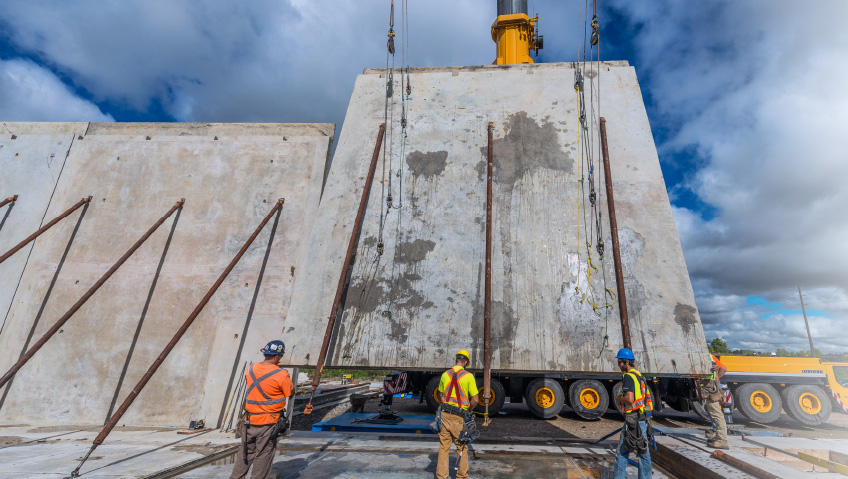Chandos Construction is a national technical builder originally formed in September 1980. The company’s founders met when working on a job at Edmonton’s Commonwealth Stadium.
The founders had connections to Ontario’s Lake Chandos so, upon deciding to enter the construction industry together, the company was named in honour of that connection.
In the ensuing 40-plus years of its history, the company has grown exponentially into a national provider with over 500 employees, seven offices across Canada, and with sales last year of around $600 million, making it one of the largest Canadian mid-sized contractors.
A major development in the company’s history came in the early 2010s when it began research into a process called integrated project delivery (IPD) and eventually shifted its work toward using the process full-time.
IPD involves the company collaborating actively and openly on a project with owners, engineers, architects, and trades alike. IPD enables a specific contract type (CCDC30) that puts key designers, tradespeople, contractors, and owners into an equal contract and replaces the more traditional construction hierarchy with a flatter management structure.
This contract means that profits are at risk for everyone, but also opens all levels to joint decision-making as the team comes up with mutually agreed-upon goals and values. Vice President of Collaborative Construction Jen Hancock feels that with this approach, team members have “skin in the game,” the result being a great project for the owner.
The IPD approach gives Chandos the ability to be more innovative – more willing to try new things and take risks.
IPD also has the added effect of enabling a greater degree of sustainability. If a client specifies a sustainable project – such as a Net Zero energy building – having an IPD team aligned around that design usually leads to a higher success rate within the owner’s budget. There is also the likelihood of a team making better construction choices, connecting the entire supply chain to the design for a more collaborative approach.
Hancock sees this approach through the lens of climate justice as further contributing to sustainability, in how it can help marginalized communities and those affected by climate change. Hancock notes that Chandos wants to use the approach in community-based projects such as working with Indigenous communities in Canada to enable community members to play a more active role in the design and construction process.
Company president Tim Coldwell summarizes that the IPD approach helps manage projects with large degrees of complexity while also helping to save clients premium costs; in short, “IPD helps us build better buildings.”
The IPD approach is something of a microcosm of one of the company’s major ideals, which is referred to as the culture of collaboration, the concept that better ideas are formed through a diversity of thought and opinion among its workers. Hancock is firm that the company desires ideas from everywhere within it and seeks to leverage the experience and knowledge of everyone willing to collaborate. Hancock feels this leads to work being much more enjoyable for employees and, in turn, to a better product overall.
Chandos focuses on collaborative contract methods as opposed to hard bidding practices, leading to less conflict and a space for open and free conversation. This culture also extends to other unique aspects as all employees are given the opportunity to own a single class of voting shares, meaning that control of the company is widely distributed. Coldwell emphasizes that the company is one where everyone can become an owner, allowing for even greater collaboration and the integration of different perspectives into the process.
Around the same time as its switch to IPD and after doing several LEED (Leadership in Energy and Environmental Design) projects, the company decided to make all its projects LEED-compatible with regards to waste diversion. “We do it because it’s the right thing to do,” Hancock explains. “It is a space we are leading in. No other construction company is doing that in all of its projects.”
With initiatives like this, Chandos has established itself as a company eager to take a leadership role and say yes to all types of work while keeping true to its work in waste diversion and its use of IPD, which has led to significant projects.
Chandos Construction is also a Certified B Corporation which means that the company meets a rigorous set of standards according to various criteria such as providing living wages, encouraging employment across POC and Indigenous communities, gender diversity in the workplace, environmental sustainability, community work and more. Hancock says that the company aims to continually look at the questions asked of a B Corporation that will optimize the business, and adds that having this third-party certification is important and validating of its practices.
Chandos has been a part of many notable construction projects across the past 40 years that have refined and improved its approach to building. In fact, Hancock cites its work on the Mosaic Centre office building in Edmonton in 2013 as a significant catalyst for the way it would do business in ensuing years.
The owner and team had a focus on Lean operations (reducing waste while boosting efficiency and value) and in turn showed the Chandos team the potential of collaborative project delivery and influenced its use of both a Lean approach and the Last Planner system (an effective type of collaborative planning amongst design team leaders).
This in turn influenced projects like the Barrie-Simcoe Emergency Services Campus, where the company used IPD along with Virtual Design Construction (VDC) technologies such as 4D and 5D imaging and BIM-enabled (Building Information Modelling) platforms, further influencing markets like Ontario to adopt IPD and collaborative building for future work. It’s also notable that the Barrie-Simcoe Emergency Services Campus project team diverted 94 percent of waste – one of the highest diversion rates the company has recorded.
Other contracts of note include the company’s work on College of The Rockies in Cranbrook, BC; five buildings constructed to meet Passive House standards: quality design and craftsmanship with superior windows and a high level of insulation and heat recovery. This is the first multi-dwelling complex in Canada to be constructed to Passive House standards.
Hancock also recalls the Blatchford Energy District System project as one of note, as it was the first renewable energy system of its kind in residential and commercial development in the Blatchford subdivision of Edmonton, Alberta. At every turn, Chandos sees projects like these as the opportunity to step out and take leadership, not just on a job, but within the entire construction industry.
Given that 85 percent of the company’s pending work in early 2020 was taxpayer-funded, Chandos found itself in an enviable position around the beginning of the COVID-19 pandemic restrictions; in fact, it noted a record year in sales and net income in 2020.
Safety measures were increased on job sites while shared services and office staff switched to working from home, with institutions like a Friday stand-up meeting (meant to share ideas, improvements, and information) providing a point of information to employees and a much-needed sense of normalcy as production continued.
How these changes will affect the future of the company is too soon to tell but Coldwell emphasizes that flexibility and the ability to adapt to new situations will continue to be of utmost importance.
With these new measures in mind, Chandos will soon be underway with a project in Vancouver for BC housing, to construct an affordable housing and withdrawal management centre. Many at the company, including Tim Coldwell, have a passion for social procurement and will be working to meet a voluntary commitment of 10 percent community benefits through the construction process on the BC Housing project. Trades will look to employ local workers and those from equity-seeking groups.
The company’s climate strategy will also be a significant factor for the rest of the year, as the company looks to put a strong greenhouse emission-reduction plan into effect.
Company announcements are also on the way about its move toward Net Zero carbon, and more will be revealed before the end of the year. Coldwell notes that the company has continued to diversify its revenue geographically and has been growing from its initial Alberta location into places like Toronto, Ottawa, Kelowna, and Vancouver.
And as Chandos experiences growth and success as a national contractor, sixty percent of the company’s revenue is now sourced from outside the Prairies.
Coldwell summarizes by underlining that Chandos is a service business and a business for people: “So much is driven by culture and people and how they work with each other. Chandos is a purpose-driven national technical builder that is leading change in the Canadian construction industry.”






